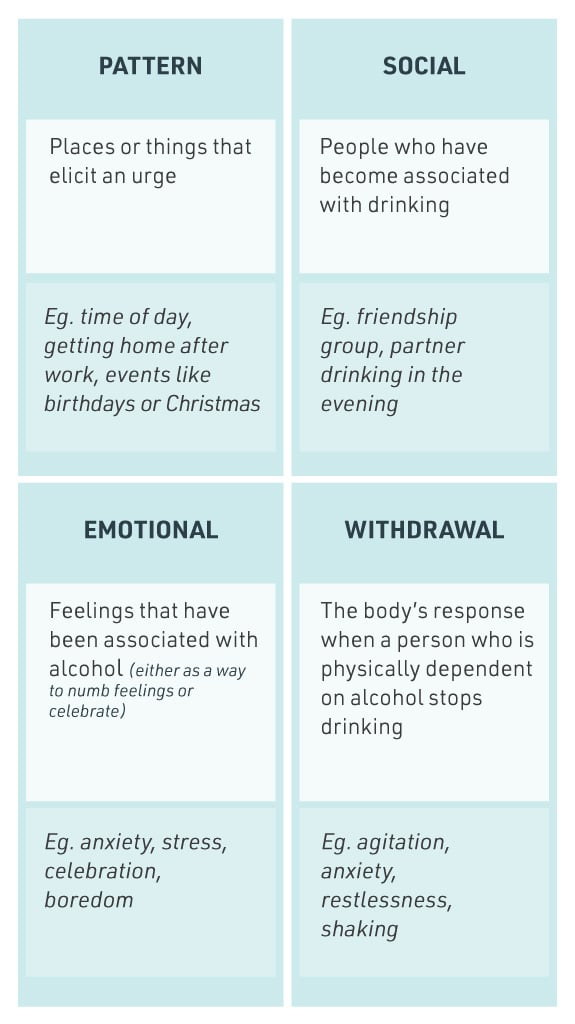
Managing Urges
Experiencing a strong desire to drink – commonly called an urge – is something that most people come up against when starting to reduce their drinking.
Learning how to manage your urges is a fundamental tool in changing your relationship with alcohol.
What are urges and triggers?
Sometimes it can feel like urges just sneak up on you and you just find yourself giving into them. This is normal in the early stages of trying to make changes. In reality, they don’t just happen randomly. Urges tend to come on as a result of how you might be feeling or thinking. There are also particular situations that trigger you to want to drink. So the good news is…
- When you figure out what triggers you to drink, you have more control over how to make changes
- Once you know your triggers you can make a plan for when they come up
Some other good news is that urges decrease over time, and they tend to be less intense and also happen less often. So the hard work you put in now to beat them now will pay off in the long run!
Most find that their relationship with alcohol changes the further they get down the path of alcohol reduction.
Urges are the feeling of needing to drink immediately. These commonly happen when you’re trying to reduce your alcohol intake.
Triggers are situations, thoughts and feelings that spark an urge to drink.
A trigger is anything that is repeatedly associated with alcohol. For example, every time you drink alcohol in the same place over time, just being in that place – even without alcohol – can bring on an urge to drink.
Most triggers fall into one of four categories – Pattern, Social, Emotional and Withdrawal.

Another way of looking at this is what is happening inside you (internal) and what is happening outside (external):

What triggers your urges?
It can be helpful to look at these categories and consider what kinds of triggers exist for you.
Check out our ‘Managing Urges’ Activity Sheet to learn more about your personal triggers.
What triggers your urges?
Often when you pick up a drink, several of your triggers will be happening all at the same time. That’s why it can be difficult to make changes in the beginning. Take a look at the personal stories below for examples of the different types of triggers.
Anna
Anna was drinking 1 bottle every evening. She was under a lot of pressure at work and having challenges with her extended family falling out with each other.
Triggers
- Pattern: After work, in the evenings
- Social: By herself mostly.
- Emotional: Boredom, fatigue, exhaustion
- Withdrawal: Occasionally if not drinking, would feel restless.
Joseph
Joseph was drinking heavily after putting the kids to bed. He was experiencing relationship issues with his wife and feeling unsupported at home.
Triggers
- Pattern: Late evening after dinner and when kids are in bed.
- Social: Sometimes with friends on the weekend, mainly alone
- Emotional: Lonely, frustrated, angry.
- Withdrawal: Sometimes experiences the shakes in the morning, strong urges if he doesn’t have a drink by 9pm.
It’s useful to be aware of all the components of these situations so you can see how it all fits together. The more we can raise our awareness of certain situations or patterns that are destructive or negative for us, the better we can be at making decisions that help us move away from alcohol.
Strategies to deal with urges
Sometimes you can’t avoid risk situations or triggers. So what do you do when you’re in those situations and have the urge to drink?
Urges can be frustrating when you’re trying to reduce your drinking. You could be travelling along well with going alcohol free, or reducing your number of drinks, and then at 5pm, the feeling strikes – the feeling that you ‘need a drink’. What is actually happening is that your brain’s reward pathways are leading to the strong desire to have a drink. They have been activated for so long now your brain has trained you to believe that a drink is what you need right now. Cravings and urges are like a stray animal, if you feed them, they keep returning.
Check out our top three strategies below to deal with urges:
Urges come and go, and over time, they get weaker and shorter the longer the time you’re not drinking. Because of this fact, a useful technique for managing urges is what we call ‘Urge Surfing’. This is a widely used mindfulness technique to help beat urges for food, drugs or alcohol. With a bit of practice, you can retrain your brain to beat the urge.
When you notice an urge, rather than fighting against it, imagine you are on a surfboard riding with it. Instead of struggling and trying to get rid of the urge, see if you can observe what it is bringing up in your body, and what your mind is telling you. Urges are similar to waves, in that they build up to their cresting point and then fall. As the intensity of an urge builds, it can feel like it will last forever – but we know that, actually, most urges only last for 20-30 minutes, and if we can delay acting for the period of time, we are in a good place. We’ve included some techniques in our ‘Managing Urges’ Activity Sheet.
By practising urge surfing, your brain learns that it doesn’t have to react to its impulses, and those urges lose their control over you.
Another great technique for managing alcohol use is called the 3 Ds – these are easy-to-remember instructions for when you have an urge to drink, and have helped many people who are wanting to change their relationship with alcohol.
1. Delay: if you have an urge, the first step is to delay the decision to give in to the craving for a set time – whether that is 5 minutes, 10 minutes, or longer.
2. Distract: the second step is to do something to occupy yourself while the urge passes. Depending on how you experience urges, this might be something physical, or rewarding (eg. calling a friend, taking a shower).
3. Decide: after the set time, decide to yourself whether it is worth it for you to have a drink today, using a pros and cons list.
Replacement behaviours can be thought of as stepping stones – things that ‘bridge the gap’ between the old behaviour and the new.
Often when we are finding that there are certain times or triggers for us to want to drink, what can help is a ‘stepping stone’ approach away from it. That could involve coming up with some replacement behaviours to replace the drinking, while you get used to not having the alcohol there.
When we are thinking about what replacement behaviours and drinks to choose, consider ones that are easily accessible and possible – and that you enjoy. Examples include: scheduling an evening walk after work with a podcast, and coming home to drink some soda and lime with your partner before cooking dinner.
Particularly if having a drink was a way to relax, we need to make sure that you still have that opportunity – that there is some time set aside for you to wind down after work. Often people find that it was not the alcohol that was beneficial, but more the ‘closing a chapter’ on the day – having a space of time to unwind and think about the day, or chat about it with someone.
For more ideas on replacement behaviours check out our ‘Managing Urges’ Activity Sheet.
In summary
- There is a difference between urges and triggers
- Triggers influence your urges
- There are many strategies to deal with urges (e.g. Surfing the Urge, the 3 D’s, Replacement behaviours).
Want to learn more?
Organisations and Services
DirectLine (VIC) 1800 888 236
ADIS (all other states)
- NSW: 02 9361 8000 (Sydney) or 1800 422 599 (NSW regional and rural)
- WA: (08) 9442 5000 or 1800 198 024
- TAS: (03) 6233 6722 or 1800 811 994
- SA: 08 8363 8618 or 1300 131 340
- QLD: (07) 3837 5989 or 1800 177 833
- NT: 1800 629 683 (NT general) or 08 8922 8399 (Darwin) or 08 8951 7580 (Alice Springs)
- ACT: 02 6205 4545
Books and Articles
There are lots of great books and articles offering help. We have selected a few to get you started:
- This naked mind – Book by Annie Grace
- Tiny Habits – Book by BJ Fogg
Find Support
If reading this brings up tough stuff for you, please talk to a trusted family member, friend, GP or one of the other services listed on our Find Support page. For additional support, we encourage you to follow the recommendations provided to you in your Personal Snapshot Report.






